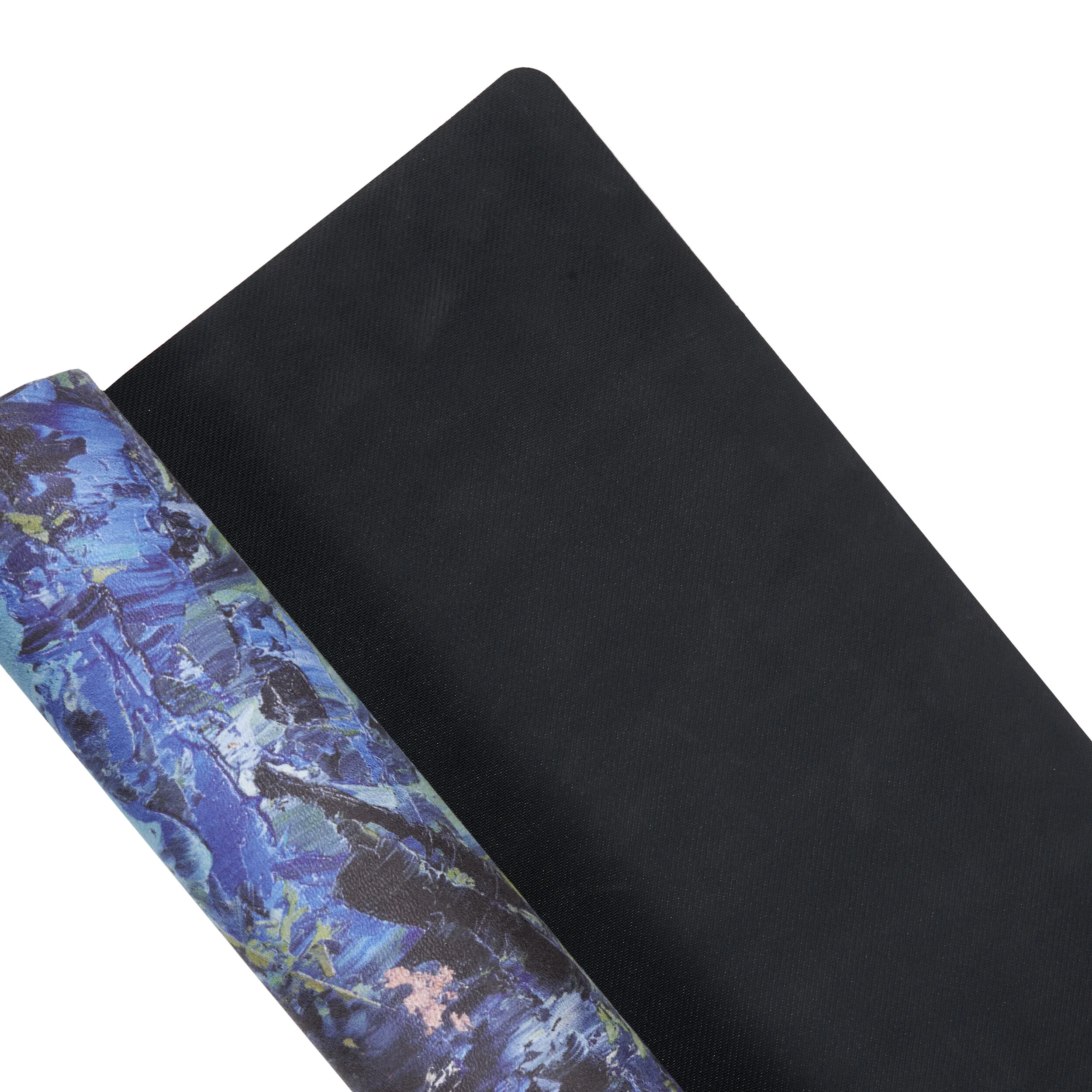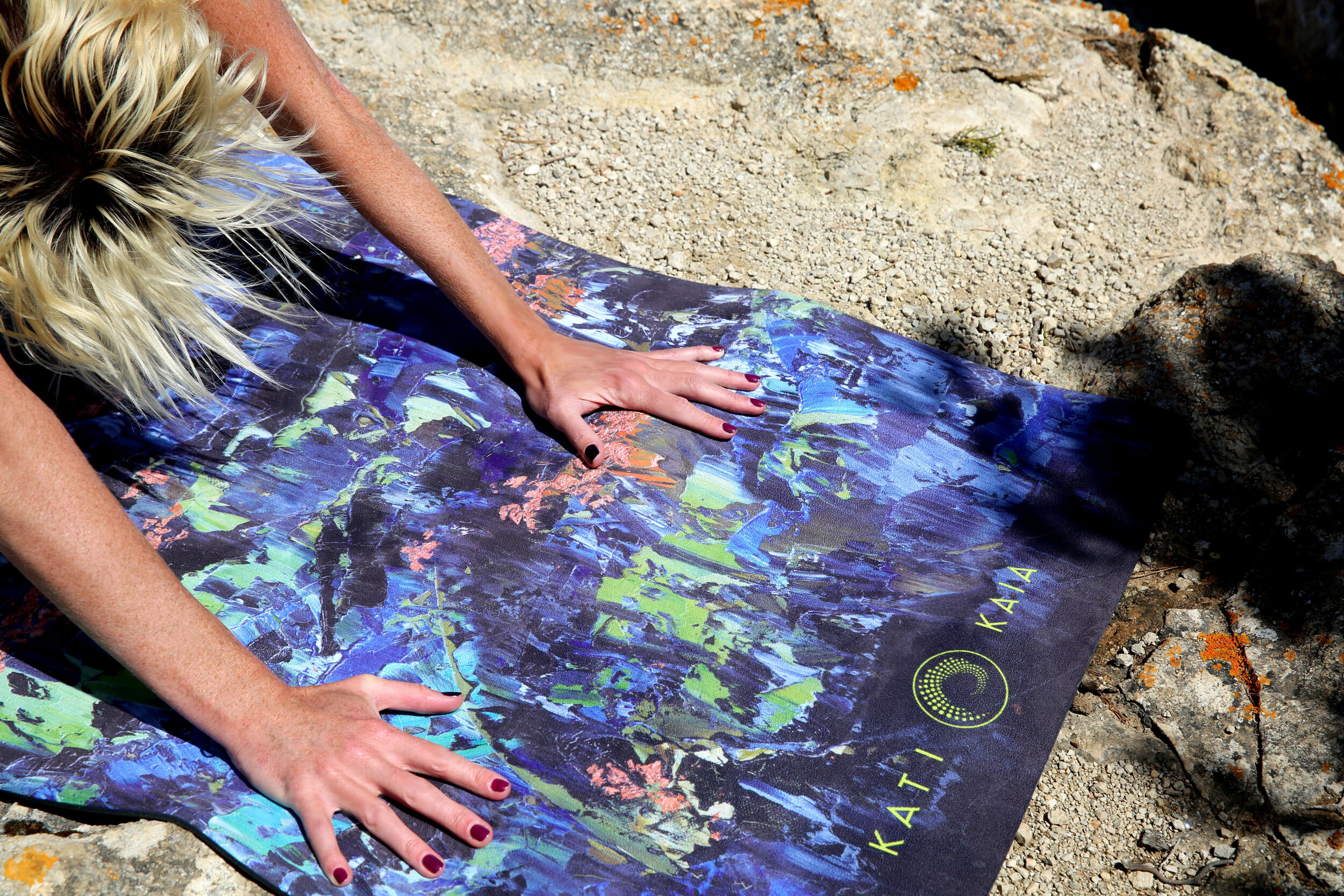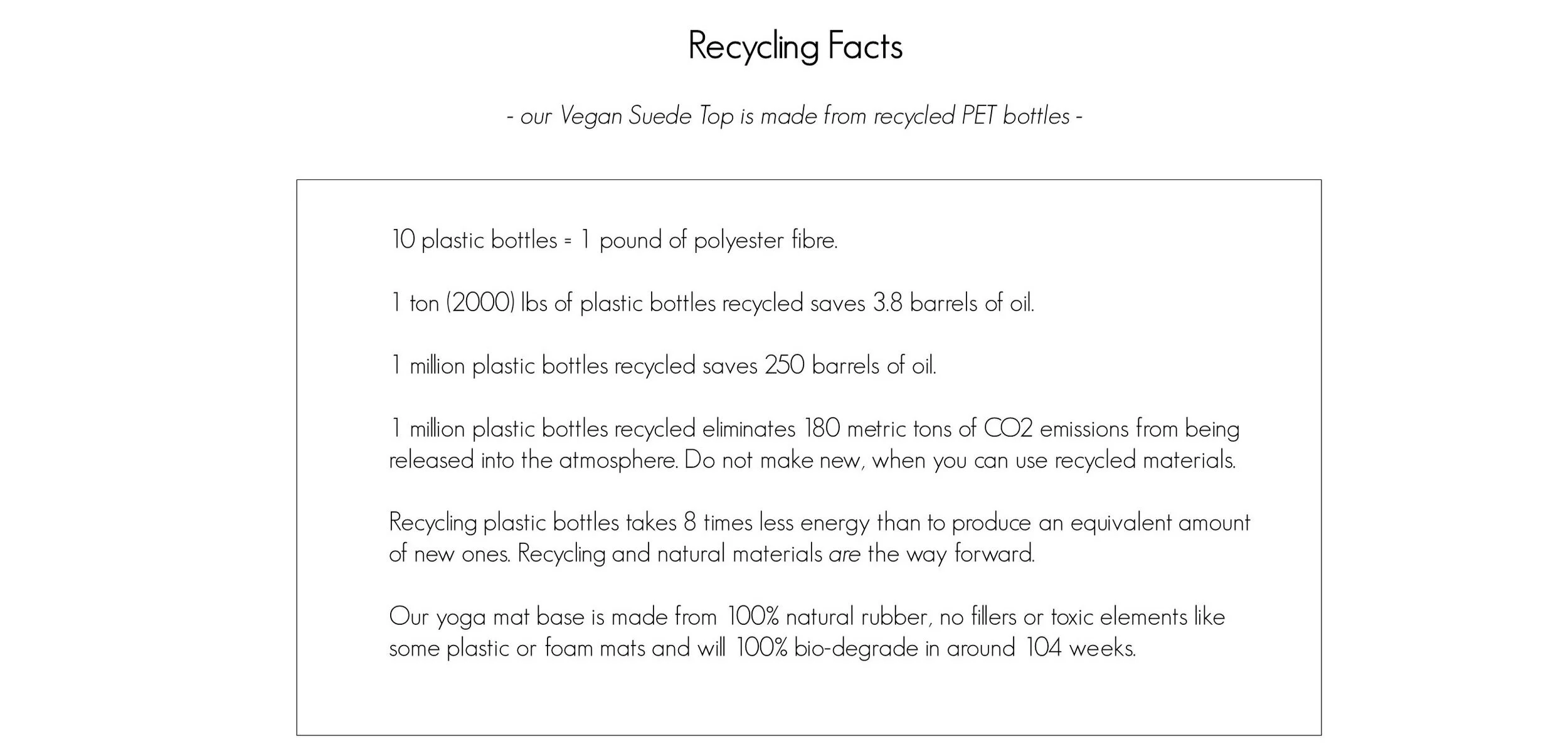Choosing a yoga mat is now a pretty hard choice, there is such a variety out there, all with different benefits and uses, price points and shapes! We thought we would run through what many mats are made from, which are the most sustainable choices and which you should steer away from as a conscious consumer. Once you find your mat, it is your companion for years to come.
We of course think natural rubber is an excellent balance of sustainability and a beautiful product that will last, but we get asked this question a lot - so thought it would be nice to share all our knowledge on yoga mats - the good - the bad - and the ugly!

Get ready, there is a bit of science stuff in here...
The cheapest yoga mats on the market are usually made from plastic (PVC) or an EVA/TPE foam, which is lighter to carry and cheaper and easier to make in a mold. The EVA/TPE is widely used as an eco-friendly alternative to plastic or PVC* mats. Do not buy PVC, this is probably the worst to recycle, it is slippery when wet and though very light, it is cheap and not an eco choice. We need these mats to go out of fashion so they are produced less and take up less landfill. If you do have a PVC mat, you can donate it to a local charity. Chemicals such as volatile oil compounds (VOCs) and poly-cyclic aromatic hydrocarbons (PAHs) are emitted as a breathable gas from PVC! So don't get hot and sweaty on a PVC yoga mat!
TPE is promoted as eco-friendly and non-toxic but made with petroleum materials such as PER (Polymer Environmental Resin) or TPE (Thermoplastic Elastomer). These materials may be better than PVC*, in terms of energy requirements and some toxicity**, but they are far from natural and may still contain toxins other than phthalates. They can also sweat with heat... hence why these are the mats get slippery as you use them in a sweaty practice and they also release some chemicals (that's why they smell). They do have a great grip, though are possibly too spongy for asana practice when you need to feel into the floor, though have good cushioning for Pilates. They should not be used in any environment with heat as it’s heat that can release chemicals, these toxins can be inhaled as you breathe deeply into your mat.
TPE can mean pretty much anything from a type of plastic, so it's a bit of a minefield when you start to research... Many TPE mats aren't practically biodegradable in the greenest terms and some of the constituents have been created using very high energy. It's best to check with individual companies about what is in their TPE products and what TPE means to them. When it bio-degrades, how long that takes and what does it bio-degrade into, what dyes are used etc?
Finally, according to wiki, Thermoplastic elastomers generally "creep" and demonstrate: "poor chemical and heat resistance, high compression set and low thermal stability. TPEs soften or melt at elevated temperature above which they lose their rubbery behaviour. TPEs show creep behaviour on extended use".
The definition of "creep" is
"the tendency of a solid material to slowly move or deform permanently under the influence of stresses. It occurs as a result of long term exposure to high levels of stress that are below the yield strength of the material. Creep is more severe in materials that are subjected to heat for long periods, and near melting point. Creep always increases with temperature." (wiki)
So regular use of a yoga mat for asana would be considered a ‘stress’... and hot yoga, or practicing outside (sun) most certainly would qualify as increase in temperature.

So moving away from the bad, into the good!
The most natural and eco-friendly and natural mats can be made from Jute, Cotton, Cork (requires care as the top can crack easily), Wool and Natural Rubber.
Rubber can come from a variety of places, so you want to make sure it’s from a ‘non-Amazon’ source. Our Natural Rubber base is sourced from Vietnam, which is one of the best places that rubber naturally grows and where the rubber plantations and industry is well established and regulated. Realising the urgent need to promote a shift toward more sustainable industrial development pathways, Vietnam’s government has paid special attention to the promotion of green industry which includes the Natural Rubber plantations, a resource for years to come. You can read more about our Rubber sourcing here.
‘Natural rubber has been identified in the national orientation for sustainable development, especially in facilitating hunger elimination and poverty reduction in Vietnam.’
Many of the best yoga mats on the market have a natural rubber base - they have great grip to the floor, are washable and chemical free. They will also last much longer and so the energy involved in manufacturing is spread. They are much heavier than plastic PVC mats, which in turn is actually lovely and grounding in yoga practice but more weight to carry to class. If you want a lighter mat for class - you can go for a thinner weight base or natural Cotton or Jute, which has no cushioning for your joints and is very eco friendly.
As opposed to synthetic rubbers, which are made from petrochemicals, natural rubber is made from the latex sap of rubber trees (although other plants also produce latex, rubber trees are the most efficient at producing rubber, making them the suppliers of latex for 99% of natural rubber).
Natural rubber has flexibility and strength, as well as impurities and vulnerability to environmental conditions and hydrocarbons. Compared to other rubbers, natural rubber is one of the most flexible types, and it’s resistant to water and certain chemicals. It’s also resistant to cutting, tearing, wear, fatigue, and abrasion, making it a great supportive base for yoga. Additionally, it has a lot of tensile strength and adheres easily to other materials (hence how we can easily fuse with heat alone and no glues to our vegan suede top).
Cotton Yoga mats can be a great eco and natural option. They offer no real grip by themselves, but are absorbent, easy to clean, and are non-toxic, so are great as a topper to a grippy base. Be sure to choose organic cotton as conventional cotton is grown using vast amounts of pesticides and water, which makes it rather less eco-friendly than it might at first seem. Some do come with rubber grips underneath or you could lay over a rubber base or something similar to grip to the floor and give some cushioning.
Wool Yoga Mats have also been appearing on the market and are great alternative. They are ‘soft/fluffy’ and feel lovely, but it’s a distinctive taste for those that practice in the cold or like the cosy soft-touch in their practice, if you sweat a lot this is not a good option, though wool is naturally antimicrobial, it might require a lot more cleaning. Could be a lovely feel during those colder winter months for Yin Practices.
Many yoga mats like ours have a topper to offer extra protection for the base, this gives your mat further life, protecting the wear of the base and offers the two sides for practice depending on what your needs are. Natural rubber has excellent grip, which is really what you need against the floor. Adding a layer on the top, however thin or thick can give more protection against wear and is also a barrier for sweat and other things that might linger around, which makes them easy to care for. Mostly these would be fused together using heat alone - but you should check with the manufacturer. The tops can be from a variety of materials that all offer different levels of grip, eco values and experience. It’s good to research each top and what care it might need, as natural surfaces like cork can crack without proper care.

The Top of the mat, can be a different material to the base.
Vegan Suede - The top of our mat is made from recycled PET bottles, it is soft to the touch, yet super grippy, especially when you have some heat in your hands or you can simply spritz the top, perfect for a sweaty practice. Ours is printed with water-based inks, which in manufacturing means the print heads can be cleaned easily and with no toxic chemicals, then fused to the natural rubber base using heat alone and no glues. The recycled top is a woven microfiber - the bottles are chipped and made into a fibre which is then woven - in this process the chemicals in plastic are evaporated - which is why it is so versatile and saves so many bottles from landfill, taking less energy to make than new microfibre and a really soft and beautiful touch.
We have to re-use plastics, they don’t simply disappear, so the best thing to do right now is to recycle them. PET bottles can be made into new cloth and is used in various industries such as bags, sportswear, clothing etc, you can read more about how that happens here.
Water-based inks are, as you’d expect, made with water. Unlike plastisol inks (usually used in printing as they produce such amazing colour depth), water-based inks don’t contain PVC. This means they are eco-friendly and work a bit differently than other inks. It can be very difficult to get right, it takes a few tests and samples to match colours, but it's a balance, the print heads are easier to clean as well just needing rinsing with water alone - no chemicals.
The Vegan Suede we use is soft to touch but also absorbent - great for sweat and gets more grippy as you use it, instead of the other way round, so no need to chalk for grip as in bases without a top, you can simply spritz with water. This top also protects the rubber base from germs and sweat, adding a barrier to make the base last longer - you can simply wipe down the top well after practice, protecting the base and wash the whole mat periodically for a deep clean. It is also easily recyclable and will biodegrade in about 40 weeks.

Though we encourage donating your mat after use, there are many drop off points in the UK for donations to the refugee crisis in Europe and Internationally or help the homeless organisations, who would very much appreciate donations. Used yoga mats can make excellent sleeping mats, ground flooring for tents and beyond. There are many grassroots organisations across the UK and worldwide. There is never any need for yoga mats to end up in landfill.
Attitudes to product is changing, which is fantastic. The more we care about not making new plastics and what goes into our surroundings and products the better. If you want to ask any more questions, we are more than happy to help and if we don’t know the answer we can certainly find out!
We can all rest fully in Savasana.
*PVC - Chemicals such as volatile oil compounds (VOCs) and poly-cyclic aromatic hydrocarbons (PAHs) are emitted as a breathable gas from PVC yoga mats, as well as from carpets, furnishings, paint, cleaning supplies, printer ink, and other household products.
**Phthalates are another chemical often found in yoga mats. This chemical is used to make PVC flexible, but it has been shown to leach out of materials when they become warm, making it a particular problem for anyone doing Bikram yoga. Phthalates can attach to dust and are then breathed in. Phthalates have been linked to a range of troublesome health issues, including infertility, menstrual problems and other conditions and diseases including carcinogens. Time we stopped making product entirely with PVC.









0 comments